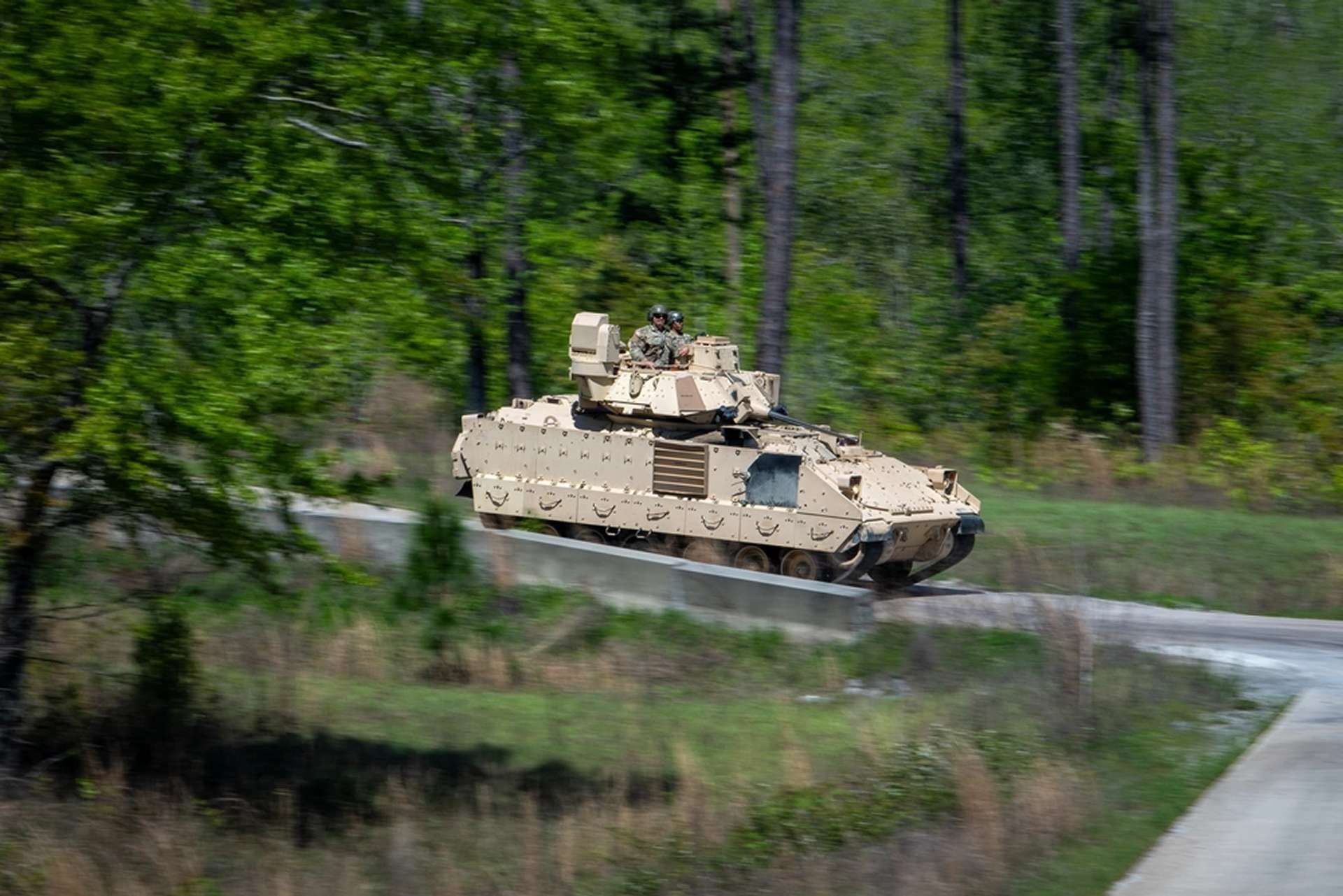Breaking news
US Army deploys nearly 100 new M2A3 and M3A3 Bradley IFVs near Russia.
As reported by the US Army on June 4, 2024, soldiers from the 1st Armored Brigade Combat Team, 1st Cavalry Division received nearly 100 Bradley Infantry Fighting Vehicles (IFVs) at various locations across Poland and Lithuania between May 20 and May 31, 2024. The vehicles, sourced from the 405th Army Field Support Brigade's Coleman Army Prepositioned Stocks-2 worksite in Mannheim, include both M2A3 Infantry Fighting Vehicles and M3A3 Cavalry Fighting Vehicles. Although the two variants are nearly similar, the primary difference between the M2A3 and M3A3 lies in their roles.
Follow Army Recognition on Google News at this link

Soldiers from the 1st Armored Brigade Combat Team, 1st Cavalry Division received nearly 100 Bradley Infantry Fighting Vehicles (IFVs) at various locations across Poland and Lithuania between May 20 and May 31, 2024. (Picture source: US DoD)
The M2A3 Infantry Fighting Vehicle is a version of the Bradley Fighting Vehicle designed to transport infantry to key areas on the battlefield while providing fire support. It is equipped with a 25mm M242 Bushmaster chain gun, a TOW missile launcher, and a 7.62mm M240C machine gun. The M2A3 also includes optics and electronics for target acquisition and communication. It can carry six infantrymen in addition to its three-man crew, supporting various combat operations with its protection and mobility features.
The M3A3 Cavalry Fighting Vehicle, similar in design to the M2A3, is configured for reconnaissance and scout missions. It retains the same armament as the M2A3, including the 25mm chain gun and TOW missile system, but is set up to carry two scouts instead of infantrymen. The M3A3 also has additional space for ammunition and communications equipment to support its role in gathering intelligence and relaying information. This variant focuses on situational awareness and battlefield connectivity to aid in reconnaissance tasks. Both M2A3 and M3A3 Bradley Fighting Vehicles replaced older M113 armored personnel carriers in the 1st Armored Brigade Combat Team's (1st ABCT) fleet of tracked vehicles.
The 1st Armored Brigade Combat Team (1st ABCT) of the 1st Cavalry Division, also known as "Ironhorse," is currently deployed in Europe as part of a scheduled rotation of U.S. Army forces to support NATO allies and deter Russian aggression. This deployment includes approximately 5,500 soldiers from Fort Cavazos, Texas, who are replacing units from the 3rd Infantry Division and the 1st Infantry Division in various locations across Europe.
The 1st ABCT is accompanied by other elements of the 1st Cavalry Division, including the division headquarters, the 1st Combat Aviation Brigade, the division artillery, and the sustainment brigade. These units are engaged in joint and multinational training exercises with NATO partners to maintain readiness and strengthen international military cooperation. This rotation is part of ongoing U.S. efforts in Europe, which have been reinforced since Russia's annexation of Crimea in 2014 and further intensified following the 2022 invasion of Ukraine.
The deployment of this unit in Europe is expected to last approximately nine months. Upon their return to Fort Cavazos, Texas, the 1st Armored Brigade Combat Team (1st ABCT) is scheduled to receive the latest M2A4 Bradleys, making the current issuance of M2A3s and M3A3s an essential step in their transition to more modern equipment.

The M2A3 Infantry Fighting Vehicle is a version of the Bradley Fighting Vehicle designed to transport infantry to key areas on the battlefield while providing fire support. (Picture source: US DoD)
The U.S. Army Field Support Battalion-Poland (AFSBn-Poland) has been involved in this effort to equip American soldiers in Europe with Army Prepositioned Stocks-2 (APS-2) as part of broader Army modernization efforts. In September 2023, the battalion divested nearly 120 Bradley Fighting Vehicles from the 2nd Armored Brigade Combat Team, 1st Cavalry Division, to prepare for new equipment fielding after their nine-month rotation in Europe. These APS-2 support activities have significantly influenced equipment modernization and overall readiness across the Army, extending beyond Europe.
Maj. Steven Waugh, the support operations officer at AFSBn-Poland, underscored the significance of the Bradley modernization efforts. He participates in weekly operational planning meetings to stay updated on his role and the Army's goals for equipping armored brigade combat teams with advanced weapons. His knowledge of Bradleys has increased significantly during his time at AFSBn-Poland. The team worked extensive hours to ensure the Bradleys were ready for deployment, with 1st Cavalry Division soldiers reporting high satisfaction with the vehicles. As part of the 405th AFSB's regional alignment and transformation initiative, AFSBn-Poland is moving its resources from Mannheim to Powidz, Poland, where a new Long Term Equipment Storage and Maintenance-Complex (LTESM-C) is located. Subsequently, Army Field Support Battalion-Germany will assume command of the Coleman APS-2 worksite and continue overseeing the Dülmen APS-2 worksite.
The Army Prepositioned Stocks-2 (APS-2) program strategically places vital equipment and supplies in key locations to ensure U.S. forces in Europe can respond rapidly to emerging threats and crises. It reduces deployment timelines and enhances operational readiness by maintaining high levels of preparedness for combat-ready equipment. APS-2 supports various missions, from combat operations to humanitarian assistance, and bridges the gap between home station logistical readiness and the needs of deployed units.

The M3A3 Cavalry Fighting Vehicle, similar in design to the M2A3, is configured for reconnaissance and scout missions. It retains the same armament as the M2A3, including the 25mm chain gun and TOW missile system, but is set up to carry two scouts instead of infantrymen. (Picture source: US DoD)


























